“Digital is what unlocks the future of the medium” James Tynion IV and Jeremy Rock The Eighth Seal
 What do you get if you cross political TV series The West Wing with classic 80s horror movie John Carpenter’s The Thing? Well if that sounds like your kind of thing then The Eighth Seal is your kind of book. From the twisted minds of James Tynion IV and Jeremy Rock this brilliant politico-horror book first showed it’s hideous face on Mark Waid’s Thrillbent site, but has now been given the full ComiXology treatment. To find out more on the best way to scare the bejesus out of your readers we got in touch with James and Jeremy and in doing so, they gave us an exclusive look at the new cover – but be warned!
What do you get if you cross political TV series The West Wing with classic 80s horror movie John Carpenter’s The Thing? Well if that sounds like your kind of thing then The Eighth Seal is your kind of book. From the twisted minds of James Tynion IV and Jeremy Rock this brilliant politico-horror book first showed it’s hideous face on Mark Waid’s Thrillbent site, but has now been given the full ComiXology treatment. To find out more on the best way to scare the bejesus out of your readers we got in touch with James and Jeremy and in doing so, they gave us an exclusive look at the new cover – but be warned!
Tell us a bit about the inspiration for The Eighth Seal? Which came first the idea of the horror subplot or the political one? For me it reminds me of both the West Wing and John Carpenter’s The Thing – what a combo!! – did any of those have a bearing on your ideas? Also where did the inspiration for the title come from?
JT: For me, it started with horror. I was just getting my feet wet in the superhero world when I first stumbled across what Mark Waid was doing with Thrillbent. I was already eager to try and build something in the creator owned field that could use my deep love of the horror genre. I saw a great opportunity in the layering techniques that were being used in stories like Luther and Insufferable, and my brain started racing about how I might be able to use those techniques to draw out scares in a comic like you can’t do in print. The only opportunity in a print comic to really shock someone is on the page turn. On a digital reader, every moment has the power to frighten. I knew I wanted to do something that involved reality breaking down. I wanted to see a person’s life fall apart while they think they’re going insane. The political angle came mostly from me realizing how much more terrifying it would be to have this happen in such a powerful environment. But that gave me the logline that helped me sell the concept to Mark. “Rosemary’s Baby meets the West Wing.” So you definitely hit the West Wing connection right on its head, but The Thing’s influence here is more subtle in my part. It’s easily my favorite horror movie of all time, but where you get the influence on a larger scale definitely comes through my partner in crime, Jeremy.
JR: I grew up on tons of science fiction and horror, so I guess some of that stuff is seeping into the visuals of The Eighth Seal. In terms of horror, John Carpenters The Thing definitely left a huge impression on me when I was young. I love the pacing and character development in that film. Plus the visual effects were brilliant. I’m not sure what else is coming through in my work though. I have too many influences to list and I find new ones every day. Naoki Urasawa and Stanley Kubrick have become bigger influences lately but I’m not sure if that shows in my current work.
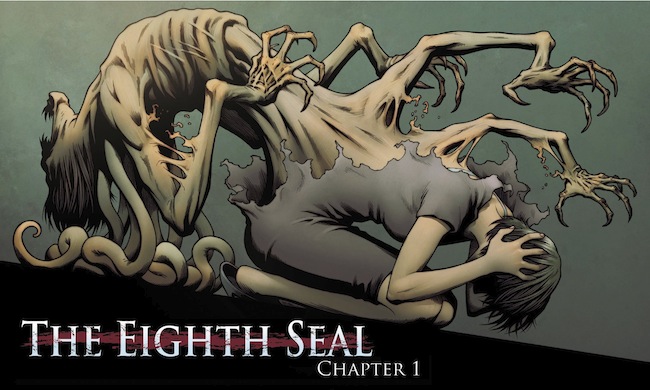
At what point did the idea of digital publishing come up? And how did you hook up with the guys at Thrillbent? (Did you always plan to do it together or did Thrillbent put you two together on this?)
JR: Back in early 2011, Mark Waid asked if I wanted to join him in exploring digital storytelling. We worked to recreate his short story, Luther, into a digital comic. Around six months later Thrillbent was born. Luther was basically R&D for Thrillbent and an example of the direction that Mark wanted to explore with digital comics. So I’ve been connected to Thrillbent for a long time but due to other commitments I had to step away for a little while. Late last year, I told Mark that I was ready to jump back in. We had talked about working together on a Thrillbent title but his schedule was too full to take on another Thrillbent series. Mark asked if I wanted to work on a comic project with him in print but I was only interested in creating digital comics. So Mark sent me a few scripts that some other writers had submitted to Thrillbent. One of those scripts was for a story called The Eighth Seal. I had no clue who James Tynion was at the time but I felt his story had the potential to be a great digital comic. James and I hit it off pretty well the first time we chatted about the project. We seem to have good creative chemistry and I think that’s because we have similar taste when it comes to storytelling. He’s a lot of fun to collaborate with and has become one of my favorite writers.
JT: Heh. Last summer I don’t think I even knew who the hell I was, so no worries, Jeremy. But that’s exactly right. I pitched the comic to Mark Waid as a concept for a digital comic, and then he made the introduction to Jeremy, and we’ve been working together on this bad-boy ever since.
Digital comics are a bit like 3D movies in my mind, in that they suit certain genres better than others. This is the first horror book I’ve seen really make the most of the digital transitions, was that part of the inspiration for making it and do you think this medium helps you tell a more terrifying story?
JT: Yes, absolutely. We were determined from the very start to make the most out of the transitional swipe effects in every chapter of The Eighth Seal. We knew we could do something different with horror comics than anyone was capable of doing in print. I remember the first thing that came to mind when I started to think of the possibilities was reality breaking down… Seeing someone looking normal, and suddenly transforming unexpectedly into something grotesque. If you’ve read the first chapter, you know we’ve put that concept to use. The best thing about swipe effects, though, is that it’s all so experimental. Jeremy and I have no idea what’s possible with them, we just keep trying to come up with the scariest ways we can break the medium. It’s all new, unexplored territories, and half the time I’m not even convinced what I come up with works until I see how Jeremy brings it to life.
JR: Swipe effects definitely shine with horror stories since the element of surprise plays such a huge role in the genre. The thing is, just about every story, in every genre, uses surprise or reveal moments. The timing of a joke in a comedy, the reveal of a character in a mystery or the moment a hero appears to save everyone in an action/adventure story. Plus these effects can do more than just be used to surprise. They can add emphasis to a moment and help make a scene feel more alive. I think swipe effects can elevate any story, in any genre, if applied properly.
We see in the ComiXology edition some of your storyboards and sketches, but tell us about how you go about planning the pages and the way they appear? Is it all in the scripting or does the artist hold the key? Do you have to work any differently to make the most of the new features?
JR: Everything is dramatically different for me on this compared to other comics I’ve worked on. I actually have some creative control for once. James is still the mastermind behind the great story but I have a lot of influence over what the story should look like and how to turn it into a digital comic. For instance, James writes a script that is usually around twelve s
creens long, we say screens instead of pages since there is no print, after I storyboard the script the comic usually ends up becoming a little over thirty screens long. I alter a lot of pacing, panel placement and word bubble placement. A lot changes but my focus is always on embellishing what James has written and not take away from his script.
Here’s a simplified step-by-step of how the comic is made: James writes a script and sends it over to me to storyboard. My storyboards are rough examples of how I think the final comic should read visually. We both look over the storyboards and make changes if we’re not happy with something. Next, I pencil and ink the final line art and then send that line art to Nolan Woodard for coloring. Nolan’s work helps bring out the atmosphere of the story. He’s one of the best colorists I’ve ever worked with and has some of the sharpest instincts when it comes to capturing the mood in a scene. Once coloring is finished, I begin editing the files to create the swipe effects. Basically, lots of cutting and pasting things together in Photoshop. After the editing is done, I send the files to the talented Troy Peteri for lettering. He chooses the fonts and refines the word balloon placement so that everything fits and reads smoothly. Troy also created The Eighth Seal logo. After the lettering is finished, I piece together the final files and create the credits and bonus material. I then send those files to Lori Matsumoto, she oversees many different aspects of Thrillbent production, and she finalizes everything for the ComiXology and Thrillbent release.
JT: Jeremy pretty much covered it all, but it’s definitely a different kind of writing. It’s not something I could imagine doing without a partner I trust as much as I trust Jeremy. I have to be looser, and think outside the box. I think Jeremy can attest that aside from when I have a few new ideas about how to do a cool swipe effect, my scripts have become much simpler. With horror, it’s all about pacing, and Jeremy’s the guy who needs to bring that pacing to life. I write loose, and try to feel clever by coming up with something cool, but when Jeremy puts it on the page, it’s always a thousand times better than what I came up with.
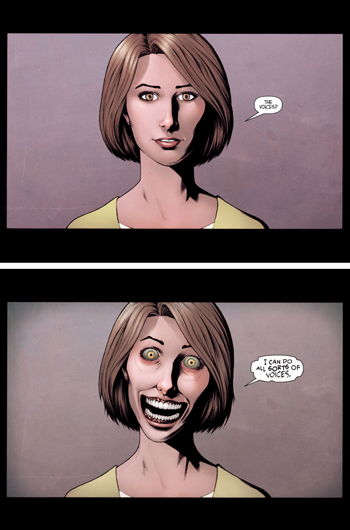
You’ve kept things relatively simple in terms of frills on the animations/transitions (compared to some of the motion comics out there), how important do you think they are to the digital reading experience?
JR: I’m not a fan of motion comics. Mostly because they turn the reader into a viewer by taking control away. Comics have always allowed people to read at their own pace. I feel that’s a very important element to keep with a digital comic. Motion comics force you to sit through their usually low-end animation and sound effects. They completely miss the point of what comic storytelling is all about. Swipe effects offer a new way to experience a comic without taking any control away from the reader. Basically, a swipe effect puts emphasis on a moment and causes the reader to notice that something changed in an unexpected way. You always have to consider how important that change is to the story. A poorly placed swipe effect can cause confusion or throw off the rhythm of a scene, which can break the readers connection to the story. It’s very tricky to do well and I still have a lot to learn with it.
JT: Yeah. From the very beginning we knew the basic tools we wanted to use. We use layering and other little swipe effects to create changes, and that in and of itself has opened up a whole world of storytelling I haven’t experienced otherwise in comics. Those tools are what defines the whole Thrillbent group of comics. There are other people out there doing really cool things with digital comics… There was an incredible stretch of Octopus Pie comics that incorporated GIFs that I absolutely loved. It was still very much a comic, not a piece of animation. There’s a lot of areas to be explored when you’re not worried about how it’s ever going to be printed in a book for your shelf. I do think some of those approaches kind of miss the point of comics, that self-control and pacing… But then again, there was this one comic I read online once, I think it was Japanese, that took the control out of your hands right as the horrifying stuff started. Like, all of a sudden, the page started scrolling down outside of my control, until it hit something terrifying. It was REALLY effective and interesting, and still definitely a comic. There are a lot of cool people doing cool stuff out there, and thankfully those pseudo-animated motion comics have mostly died out. I’m really interested to see what folks will be able to come up with next.
What for you makes a great digital comic?
JR: A great story. It’s nice that we now have access to new storytelling techniques but a good story is still the most important part of creating a memorable comic.
JT: I agree, 100%. It’s fun to use these new tools, but if we had nothing else to bring to the table, we wouldn’t be telling the story we’re trying to tell. The story is everything.
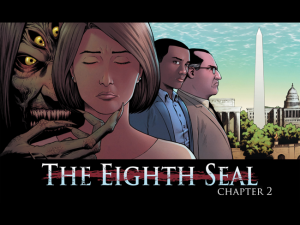 Are you guys iPad users and if so what do you make of the experience of reading comics on an iPad? Which books do you read and rate?
Are you guys iPad users and if so what do you make of the experience of reading comics on an iPad? Which books do you read and rate?
JR: I love reading comics on my iPad but I haven’t read that much lately. This project eats up most of my time, unfortunately. Reading in the dark with a backlit device is pretty damn nice. Being able to access my entire collection without having to get up and dig through a book shelf or a long box is also a relief. And then there’s the fact that I can buy a comic at 11pm if I’m in the mood for some late night reading. The only thing I don’t care for is the print portrait format on a digital device. Most traditional print comics just don’t fit that comfortably when converted to digital because of the screen and I’m not the biggest fan of “guided view” on ComiXology. That’s one of the main reasons why I wanted widescreen landscape view for The Eighth Seal.
JT: Just because I’m living in an apartment, and already have ginormous piles of comics laying around everywhere and little room for anything else, I almost exclusively buy my comics on my iPad. And then out of some sense of guilt, I tend to splurge on trades every time I make it into a comic shop, and that ends up filling all the space I was trying to avoid taking up. I love the convenience of it, but the thing I like most is what it represents. Anyone, anywhere, with a tablet or personal computer is a potential comic book reader. These days, that’s pretty much everyone. I think we’re on the verge of a massive shift in comic reading demographics, as more and more people discover how easy it is to tap in these days. All it’s going to take is the right title… I’m convinced it’ll be a Harry Potter/The Hunger Games type book that all of a sudden unlocks the Young Adult reader audience (aka the biggest reading demographic on the planet). But anyways… Digital is what unlocks the future of the medium, and I’m happy to be experimenting with the possibilities of that future.
How important do you think adding extra content is as a way to entice digital readers?
JR: Very important. We’re doing bonus material with the ComiXology version of The Eighth Seal but it’s mainly production stuff right now. That sort of thing is nice but what I really want to do for the paying readers is offer them more story. We plan to explore that in the future.
JT: I think extra content is ultimately just additive. It’s always great to have more incentives to buy or support something. That’s why we’ve started exploring different types of extra material to add into our pay versions up on comixology. Because the book is free to read on the Thrillbent website, it’s important to give the paying customers a little something extra. And we’re experimenting on what the possibilities can be there. Like Jeremy said, the ideal extra content would be some added story, and we’re thinking about how we might make that happen. Stay tuned, we’ve got some cool ideas.
How do you think the growth in digital comics has helped smaller publishers like Thrillbent, and writers and artists like yourselves? What has it been like getting in on the ground floor with such an exciting project?
JR: I love that the internet allows everyone a chance to share their creative voice. Now anyone can create a comic and share it with the world. It’s very easy to share your story but it’s still very hard to create a story so good that everyone wants to read it.
JT: It’s a tremendous new platform. Without having to worry about printing costs, companies like Thrillbent can innovate and explore with a much smaller influx of money. I think we’re going to see a lot more companies like Thrillbent as we move forward, each with their own little sets of quirks and styles. And on top of that, people are now able to self-publish via ComiXology, which opens up a whole new set of possibilities. It’s impossible to say what the comics market is going to look like five, ten years down the line, but it feels like we’re at the start of something big. Something important. It’s a thrill to feel like I’m a part of that, even in just a small way. I don’t want to get lost in that thought, the most important thing is just to keep telling the best story I can manage, but ultimately, it’s a great feeling.
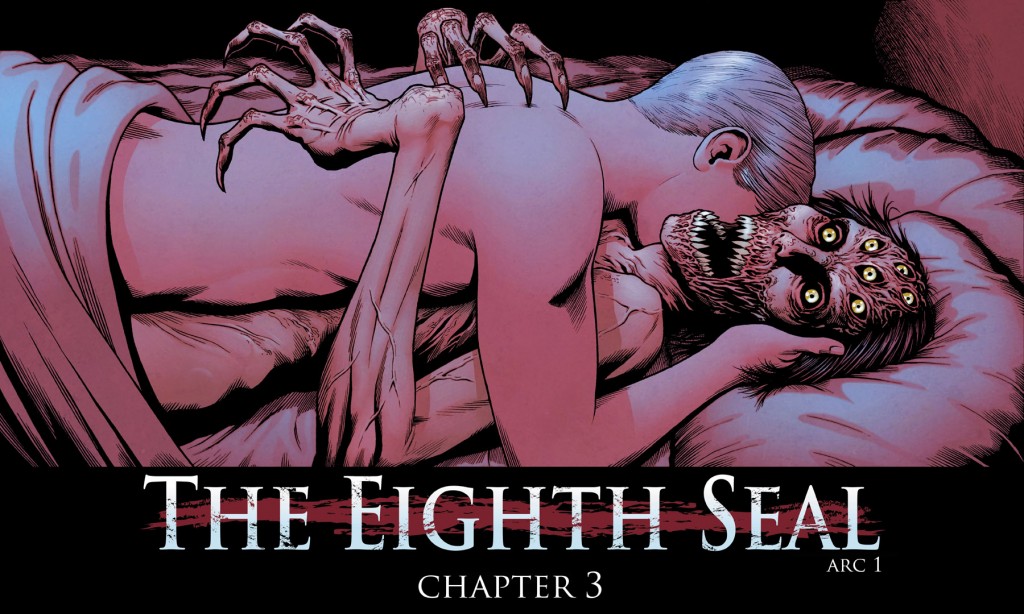
Finally, how long will The Eighth Seal be running for and any plans to work on future digital projects? What would be your ideal next project?
JR: The Eighth Seal will consist of three arcs. Each arc will be ten chapters long. As for what I plan to do after this project, I’m not completely sure just yet. I guess the thing I’d like to do most is finally finish work on a digital comic that I’m writing and illustrating myself, and put it out through Thrillbent. I’d still like to work with Mark Waid on a Thrillbent comic at some point too. And of course, I’d be more than happy to work with James on another comic.
James: I definitely want to continue playing with the digital field, although I’m not sure what shape that will take next. For now I’m going to focus on making The Eighth Seal the best comic it can be. But after that, I can’t imagine walking away from this kind of comic storytelling. I want to make sure I’m always pushing forward and experimenting with crazy new techniques. And I second Jeremy’s statement. I want to keep working with him as long as he’ll have me. This has been the greatest creative partnership of my career and I wouldn’t trade that for anything.
Issue #1 and #2 are available now via ComiXology with issue 3 available soon. For more episodes check out the weekly updates from Thrillbent and follow James and Jeremy on Twitter @JamesTheFourth and @jeremyrock
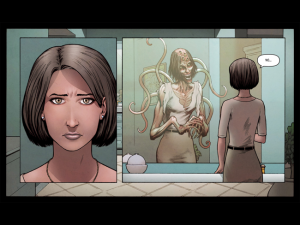



"We did our best to keep the digital reading experience fun" writer Jeff Parker and artist Jonathan Case on the secrets behind DC Comic's first digital interactive comic Batman '66 | Pipedream ComicsPipedream Comics
July 24, 2013 @ 10:01 pm
[…] Kinski. I’m also getting into the comics in Thrillbent.com ‘s group, like The Eighth Seal by Tynion and Rock, I think they’ve figured out some strengths of telling the story digitally and need to be […]
News: Mark Waid's Thrillbent unveils new DRM free storefrontPipedream Comics
August 21, 2013 @ 7:16 am
[…] 30, include collections of Insufferable, Arcanum, The Damnation of Charlie Wormwood, Pax Arena, The Eighth Seal, Luther, Moth City, and Aw Yeah Comics!, with many more to […]
Pipedream Pull List: The Endling #1 (Thrillbent)Pipedream Comics
November 19, 2013 @ 7:21 am
[…] we’ve seen in titles like The Eighth Seal and Moth City, Thrillbent‘s titles use ComiXology‘s Guided View technology to great […]